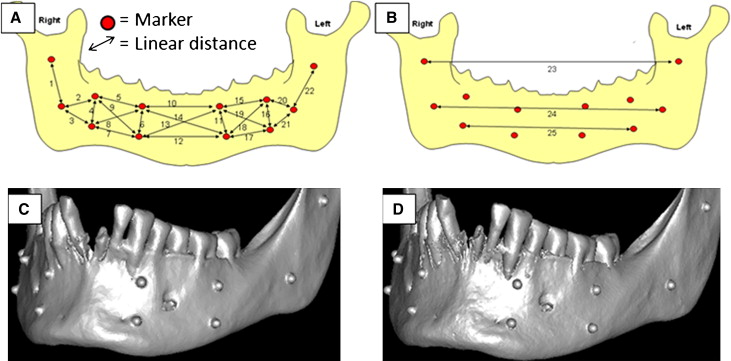Introduction
The aims of this study were to determine the linear accuracy of 3-dimensional surface models derived from a commercially available cone-beam computed tomography (CBCT) dental imaging system and volumetric rendering software and to investigate the influence of voxel resolution on the linear accuracy of CBCT surface models.
Methods
Glass sphere markers were fixed on 10 dry mandibles. The mandibles were scanned with 0.40 and 0.25 voxel size resolutions in 3 sessions. Anatomic truth was established with 6 direct digital caliper measurements. The surface models were rendered by a volumetric rendering program, and the CBCT measurements were established as the mean of the 3 measurements.
Results
The intraclass correlation coefficients between the physical measurements and the measurements of the CBCT images of 0.40 and 0.25 voxels were all more than 0.99. All CBCT measurements were accurate. There was no difference between the accuracy of the measurements between the 0.40 and 0.25 voxel size groups. The smallest detectable differences of the CBCT measurements were minimal, confirming the accuracy of the CBCT measurement procedure.
Conclusions
The measurements on 3-dimensional surface models of 0.25 and 0.40 voxel size data sets made with the 3D eXam CBCT scanner (KaVo Dental GmbH, Bismarckring, Germany) and SimPlant Ortho Pro software (version 2.00, Materialise Dental, Leuven, Belgium) are accurate compared with direct caliper measurements. An increased voxel resolution did not result in greater accuracy of the surface model measurments.
Editor’s summary
We are receiving more submissions that use cone-beam computed tomography (CBCT). Many of them aim to assess the accuracy and reliability of CBCT with measurements on the axial, coronal, and sagittal slices, or on 3-dimensional (3D) iso-surface renderings. The results generally show that CBCT accurately represents the anatomy of our orthodontic patients to a clinically acceptable degree. However, another use of CBCT is to plan surgical treatment by simulating osteotomies and performing virtual bone movements. These applications require the construction of a surface model from the CBCT data. The surface model usually consists of a dense triangular mesh that approximates the bone’s surface and is automatically constructed from the voxel data, requiring only the input of a threshold value that specifies what is bone and what is not. Once constructed, the surface model can be used independently of the CBCT data. Because they require significantly less memory storage and can take advantage of today’s graphic processors’ capability to render triangles quickly, surface models are well suited for surgical simulations on personal computers.
These researchers aimed to assess the accuracy of surface models constructed from CBCT images. It is expected that a surface model would be more faithful to the original object when imaged with a small voxel size (high resolution), but this increases the radiation dosage. These authors tested 2 voxel sizes to determine whether the radiation dosage can be kept low without sacrificing accuracy.
The authors found that the larger voxel size resulted in equally accurate models. They used dry mandibles and glass markers, which allowed establishment of the “ground truth” by direct measurements. However, this methodology does not accurately reflect clinical application, because no soft tissues are in contact with bone, thus making bone surface easier to identify.





